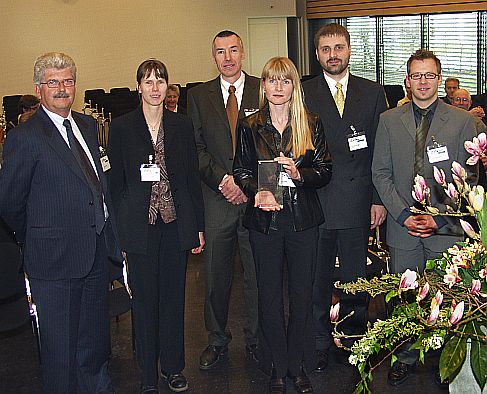EMPA Team is Awarded the Collano Prize for Innovation
Wood – a raw material for nanotechnology?

|
It is cellulose fibrils, embedded in a rigid lignin matrix in the cell walls, which give wood its stiffness and its extraordinarily high tensile strength - a functionality that we strive for in other materials too! The aim of a study undertaken by EMPA was investigate if cellulose fibrils with the greatest possible lengths, and diameters of just a few nanometers, could be separated from cellulose pulp, an industrially manufactured bulk-product, and then embedded in polymer materials. This would create a functional and sustainable material, which could be used in a wide range of technical applications. |
||||
|
||||
| Results indicate that very thin molecular cellulose fibrils, stretched as long as possible and with diameters about 5000 times smaller than those of a human hair, show the greatest potential. By employing purely mechanical methods, it was possible to separate cellulose fibrils from the pulp with diameters in the range from 20 to 200 nm and very suitable lengths of several micrometers. When a chemical digestion stage was used before the mechanical processing, even finer fibrillar structures were produced. However, in this case the length of the fibrils was reduced and the diameters were only a few nanometers. | ||||
|
The dimensions and morphology of isolated cellulose fibrils were analyzed at the EMPA using an electron microscope. Further chemical studies were made to determine the molecular weight of the polysaccharide cellulose, the smallest fibril unit. | |||
|
Wood fibrils reinforce polymers and trap water Further studies were made on the effect of embedding cellulose fibrils, extracted by various methods, in polymer materials such as polyvinyl alcohol or hydroxypropylcellulose. These studies showed that as the proportion of fibrils was raised the tensile strength of the composite increased. Even though the fibrils were oriented at random in the matrix material, the tensile strength increased by a factor of five compared to the unfilled polymer. In the course of the project, other remarkable properties of the cellulose fibrils were uncovered, in addition to their reinforcing effects. Dispersing solubilized cellulose fibrils in water by intensive mechanical means led to the creation of a transparent, mechanically stable gel. Evidently a small quantity of solid fibril network is able to trap a large amount of water. This property is very promising in terms of new uses for the cellulose gel, for example as a thickening agent in dispersion paints, where it could help to optimize the application and coverage qualities. Pushing back the frontiers with nanomaterials The cellulose fibrils have, in addition to established nanomaterials, become yet another innovative component of EMPA’s nanoresearch effort. The EMPA team is now collaborating with Collano in a project supported by the Commission for Technology and Innovation (KTI) to investigate the possibility of using cellulose nanofibrils in adhesives. During this work the team will study how to optimize the manufacture and bulk production of fibrils and conduct intensive research into other polymer-fibril combinations. Future applications of cellulose nanofibrils are difficult to specify since possibilities are nearly unlimited. Suffice to say that the extraordinary functionality of the material opens an extensive spectrum of uses, from industry to medicine. |
||||
|
Contact persons for technical information Tanja Zimmermann, Wood Lab, Tel. +41 44 823 43 89, E-mail Evelyn Pöhler, Wood Lab, Tel. +41 44 823 40 74, E-mail Dr. Thomas Geiger, Functional Polymers Lab, Tel. +41 44 823 47 23, E-mail Jürg Schleuniger, Functional Polymers Lab, Tel. +41 44 823 43 56, E-mail Editor Martina Peter, Communication/Marketing Section, Tel. + 41 44 823 49 87, |
||||
|
||||


